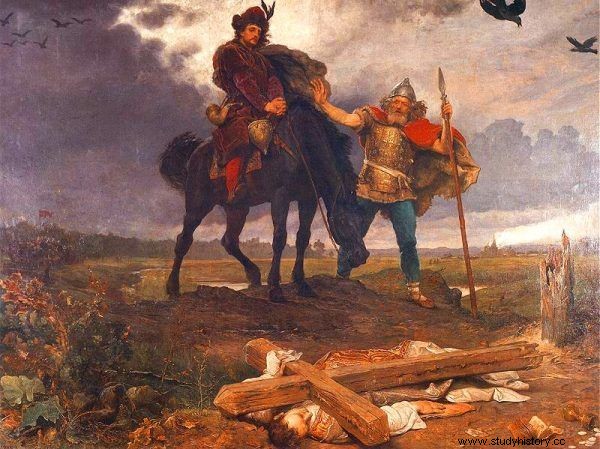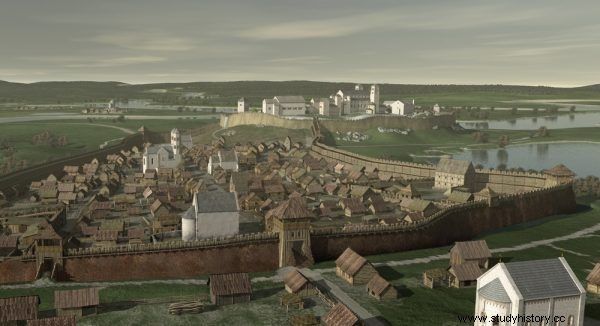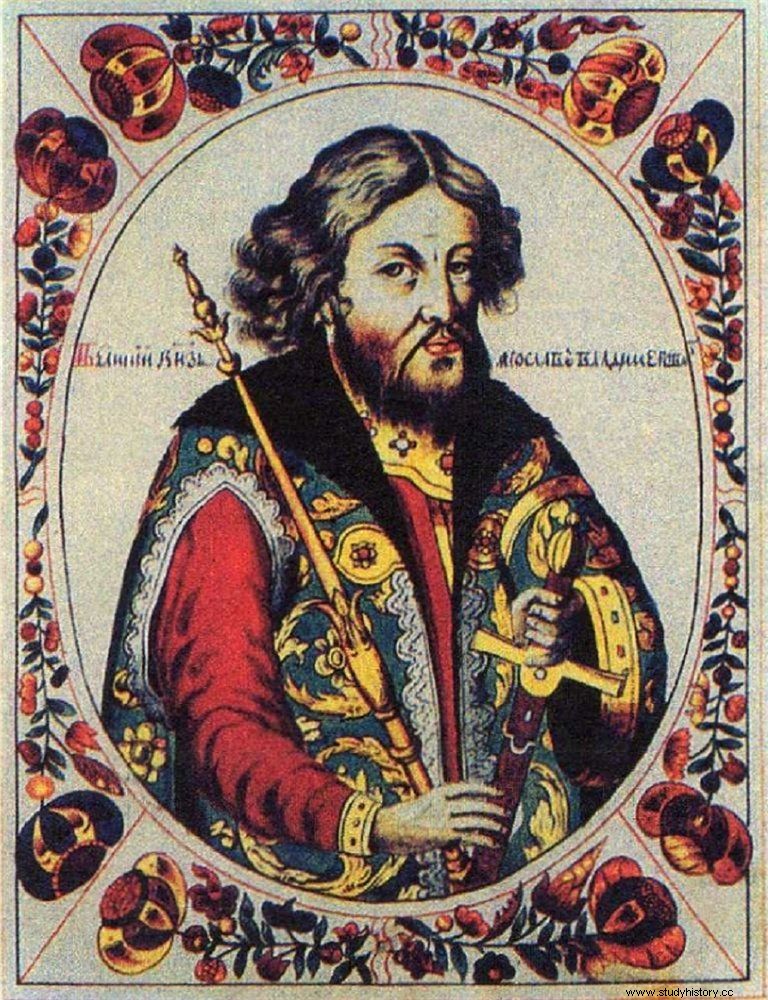Gniezno was in ruins. Poznań was ruined. Poland urgently needed a new capital. And it was not chosen by the man on the throne.
The year was 1038. And it was the worst year in the history of Poland. Deprived of experience and constantly in check by the power-hungry opposition, the prince was relegated to a deep defensive. Rebellions broke out all over the country. The grandson of Bolesław Chrobry, Kazimierz, had no room for maneuver. The enemies pushed him to Krakow, and finally forced him to flee the country. The scale of the cataclysm is difficult to even put into words. Rebel lords and foreign princes trampled the body of the fallen beast with impunity for months, taking revenge for all the wrongs suffered.
Ruins of the empire
Kazimierz returned to the country only thanks to the armed help of his relatives. Not at the head of the Polish army, but by the German meals provided by his mother, Queen Riches, and uncle Herman, who sat on the archbishop's chair. The country was completely robbed. In Poznań or Gniezno, the prince did not even have anything to look for. Ruins and ruins greeted him everywhere.

The return of Prince Kazimierz to Poland in the painting by Wojciech Gerson (source:public domain).
He didn't even try to go to Silesia. This land was now ruled by the Czechs, and they would not have been scared by five hundred heavily armed knights. In Mazovia, the treacherous teacup Miecław proclaimed himself a prince and probably even tried to establish a completely new dynasty. Only Lesser Poland remained. It wasn't a promised land. The Czechs who, in the absence of Kazimierz, organized the worst invasion in the history of Poland , they did not spare the villages of Wisła.
They offered fire to the peasants, raped women, and gave their children the surviving grain as a shelter to their own horses. However, they did not completely devastate Krakow, and they probably did not even venture to Sandomierz. The plunder in these lands was not an end in itself. The Prague prince Brzetysław in 1038 still hoped that he would manage to seize not only Silesia, but also all other lands, including Przemyśl itself. Total destruction was not in his interest.
There was still a cathedral in Krakow, there were some remains of the palace, and the Wawel Castle was surrounded by barely chipped ramparts and palisades. Churches suffered losses but were not demolished. Kazimierz could stop here relatively safely, let the soldiers rest and plan their next steps. But he did much more. He decided to stay in Krakow permanently.
The year 1039, when the prince returned to Poland, dates back to the beginning of the city's career in the capital. The ruler will never restore Poznań and Gniezno to their former glory. During his lifetime, not even a new cathedral will be built in the current burial place of Saint Adalbert. The next Piasts will also stick to Kazimierz's decision. Until the end of the 16th century, Krakow will remain the center of power and the ideological keystone of the kingdom.
City of women
The prince's decision was interpreted in various ways. The condition of the stronghold, the city's location on trade routes and the proximity of hostile Bohemia, which made it easier to counteract any attack, had to be of importance. It seems, however, that these were not arguments that tipped the scale. Krakow became the capital primarily because of two distinguished women.

Visualization of pre-charter Krakow developed by Marcin Orkisz. Illustration from Kamil Janicki's book "Ladies with a scourge" (Znak Horyzont 2016).
The first was Rycheza. Extremely influential and agile mother of the Polish prince. It was she who cared for the Vistula stronghold for many years, building local churches, organizing her own manor and elevating Krakow almost to the rank of the second Aachen. Thanks to her, the city was perfectly prepared for the role of the new capital.
It should also be remembered that it was here that the queen spent many years, both before the death of Bolesław the Brave and as a result of her separation from her husband, who prefers to play in the company of concubines. The adolescent Kazimierz accompanied her constantly. He knew Krakow like his own pocket. He felt this place was his home, even if the rest of the world he knew was on fire.
Finally - Krakow was close to Germany. Although Silesia was under hostile occupation, spies and diplomats disguised as merchants could still sneak along the local route to Saalfeld in Turin. The mother, who had lived in exile for several years, remained well-informed about Polish affairs, and her son could always count on her advice and support.
Exotic alliance
The opposite direction was equally important. Kazimierz chose Krakow because it was from here that the trail leading to Kiev ran. The prince urgently needed a strong ally. A mighty man who will help him break down the rebel forces, regain Mazovia, shave the nose of Pomeranians, and also curb the aspirations of the Czechs. He found it in a completely unexpected place.
Unfortunately, the details of the events are not known to us. We know for sure that soon after returning to Poland - in 1040 or 1041 at the latest - Kazimierz got married. And it was a wedding that had a really wide impact. Gallus Anonymous did not spare the ruler praise. He stated that he had taken a wife of "great riches" and of "noble lineage". It was a perfect marriage in his eyes. But what was the reality?

According to Ruthenian chronicles, Kazimierz had a deal with Jarosław Mądry himself. A man who until recently had been his father's ardent enemy. The illustration shows a 17th-century image of Jarosław (source:public domain).
First of all, the beginning of the relationship could not be easy. There is a short mention in the Polish chronicle that the new duchess came from Rus. More details are revealed in Kiev's chronicles. From the account written probably simultaneously with the events, it appears that Kazimierz did not get along with anyone else, but with Jarosław Mądry himself. A man who in 1018 - during the famous Kiev expedition - shamefully succumbed to his grandfather, and quite recently led to the exile of his father, Mieszko II.
To say that it was an exotic relationship is not enough. Two stinging enemies agreed . And Kazimierz had to pay dearly to convince Jarosław to accept the olive branch. Contrary to the words of the first Polish chronicler, it was not the treasures that traveled from Russia to Poland, but rather in the opposite direction. The prince was forced to plead to his neighbor. As part of his dowry, he handed over 800 slaves to Jarosław.
Taking into account the situation in Poland, it was an unimaginable number. The Russian prince, however, did not intend to yield:the prisoners were compensation for the eight hundred unfortunates who were kidnapped from Kiev in 1018 by Bolesław the Brave. And the costs did not end there. The new Polish ruler, Maria Dobroniega, has been almost completely forgotten by history.
And yet, how few politicians of that day contributed to the reconstruction of Poland and the prolongation of the dynasty that was facing the threat of extinction. She was also probably the reason why Krakow took on the role of the Piast capital for good. Kazimierz had no choice:the wife demands, the servant must.
Selected bibliography:
The article was based on materials collected by the author during his work on "Ladies with a scourge" . Some of these items are shown below. Full bibliography in the book.
- O. Balzer, Capitals of Poland 963–1138 , "Studies on the history of Polish law", ed. O. Balzer, vol. VI, issue 4 (1916).
- J. Bieniak, Mr. and Mrs. Miecław. Analytical study , Warsaw 2012.
- K. Dróżdż, Casimir the Restorer. Poland in the period of decline and reconstruction , Wodzisław Śląski 2009.
- J. Garbacik, Transfer of the Polish capital to Krakow in the 11th century [in:] Kraków and Małopolska through history , ed. C. Bobińska, Krakow 1970.
- G. Labuda, How and when did Krakow become the capital of Piast Poland? [in:] Studies on the beginnings of the Polish state , vol. 2, Wodzisław Śląski 2012.
- G. Labuda, Mieszko II, King of Poland (1025–1034). Times of breakthrough in the history of the Polish state , Poznań 2008.
